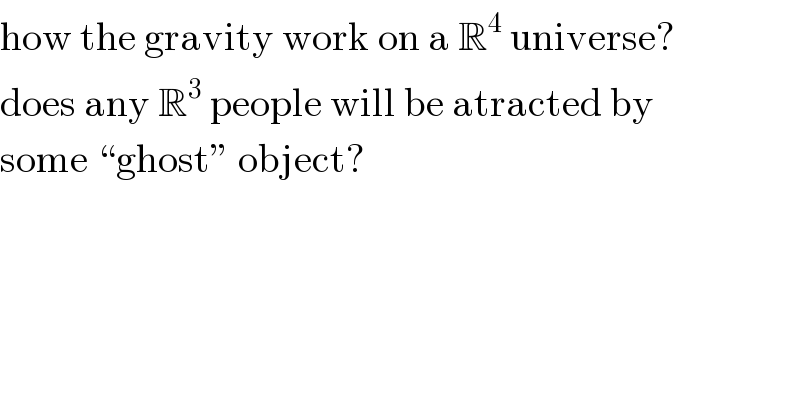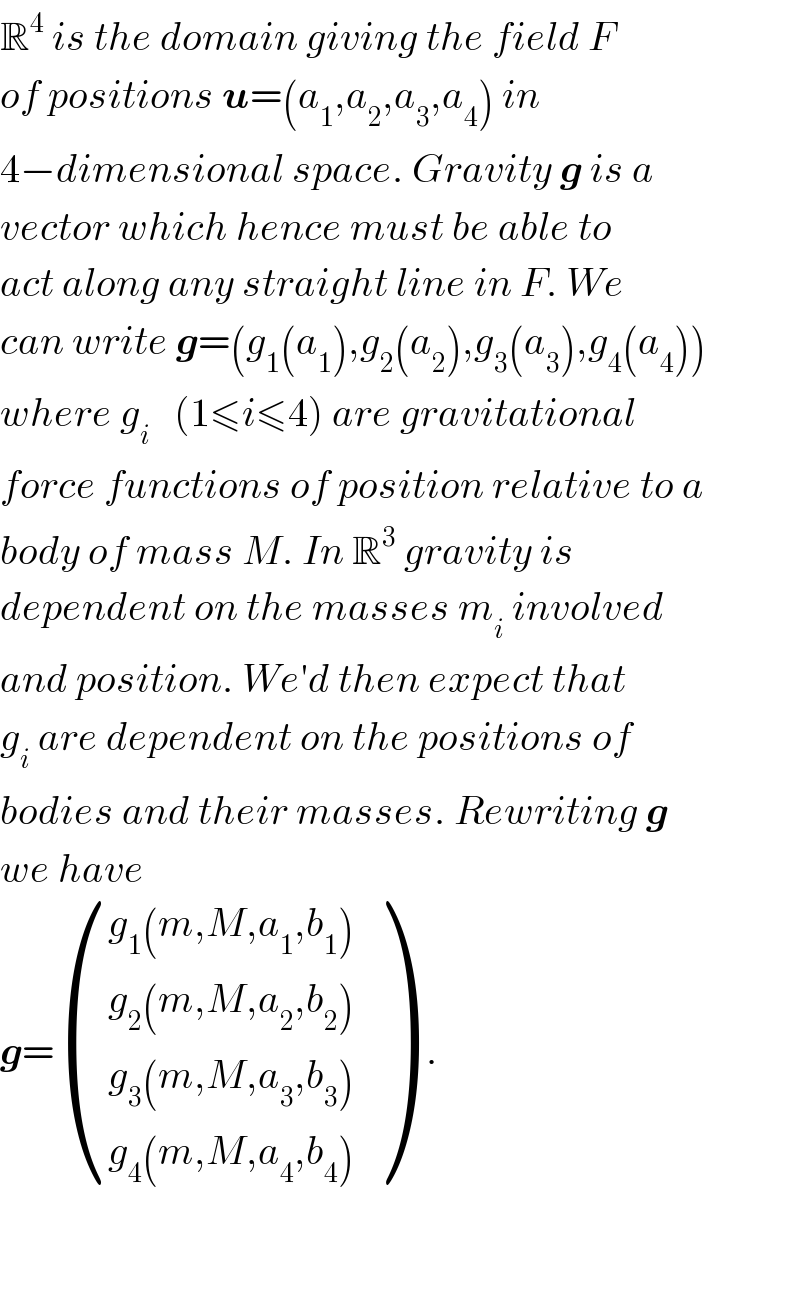
Question Number 4724 by 123456 last updated on 29/Feb/16

$$\mathrm{how}\:\mathrm{the}\:\mathrm{gravity}\:\mathrm{work}\:\mathrm{on}\:\mathrm{a}\:\mathbb{R}^{\mathrm{4}} \:\mathrm{universe}? \\ $$$$\mathrm{does}\:\mathrm{any}\:\mathbb{R}^{\mathrm{3}} \:\mathrm{people}\:\mathrm{will}\:\mathrm{be}\:\mathrm{atracted}\:\mathrm{by} \\ $$$$\mathrm{some}\:``\mathrm{ghost}''\:\mathrm{object}? \\ $$
Commented by Yozzii last updated on 29/Feb/16

$$\mathbb{R}^{\mathrm{4}} \:{is}\:{the}\:{domain}\:{giving}\:{the}\:{field}\:{F} \\ $$$${of}\:{positions}\:\boldsymbol{{u}}=\left({a}_{\mathrm{1}} ,{a}_{\mathrm{2}} ,{a}_{\mathrm{3}} ,{a}_{\mathrm{4}} \right)\:{in}\: \\ $$$$\mathrm{4}−{dimensional}\:{space}.\:{Gravity}\:\boldsymbol{{g}}\:{is}\:{a} \\ $$$${vector}\:{which}\:{hence}\:{must}\:{be}\:{able}\:{to} \\ $$$${act}\:{along}\:{any}\:{straight}\:{line}\:{in}\:{F}.\:{We} \\ $$$${can}\:{write}\:\boldsymbol{{g}}=\left({g}_{\mathrm{1}} \left({a}_{\mathrm{1}} \right),{g}_{\mathrm{2}} \left({a}_{\mathrm{2}} \right),{g}_{\mathrm{3}} \left({a}_{\mathrm{3}} \right),{g}_{\mathrm{4}} \left({a}_{\mathrm{4}} \right)\right) \\ $$$${where}\:{g}_{{i}} \:\:\:\left(\mathrm{1}\leqslant{i}\leqslant\mathrm{4}\right)\:{are}\:{gravitational} \\ $$$${force}\:{functions}\:{of}\:{position}\:{relative}\:{to}\:{a} \\ $$$${body}\:{of}\:{mass}\:{M}.\:{In}\:\mathbb{R}^{\mathrm{3}} \:{gravity}\:{is} \\ $$$${dependent}\:{on}\:{the}\:{masses}\:{m}_{{i}} \:{involved} \\ $$$${and}\:{position}.\:{We}'{d}\:{then}\:{expect}\:{that} \\ $$$${g}_{{i}} \:{are}\:{dependent}\:{on}\:{the}\:{positions}\:{of} \\ $$$${bodies}\:{and}\:{their}\:{masses}.\:{Rewriting}\:\boldsymbol{{g}} \\ $$$${we}\:{have}\: \\ $$$$\boldsymbol{{g}}=\begin{pmatrix}{{g}_{\mathrm{1}} \left({m},{M},{a}_{\mathrm{1}} ,{b}_{\mathrm{1}} \right)}\\{{g}_{\mathrm{2}} \left({m},{M},{a}_{\mathrm{2}} ,{b}_{\mathrm{2}} \right)}\\{{g}_{\mathrm{3}} \left({m},{M},{a}_{\mathrm{3}} ,{b}_{\mathrm{3}} \right)}\\{{g}_{\mathrm{4}} \left({m},{M},{a}_{\mathrm{4}} ,{b}_{\mathrm{4}} \right)}\end{pmatrix}\:\:. \\ $$$$ \\ $$$$ \\ $$
